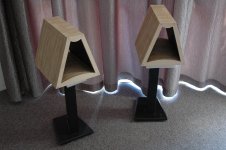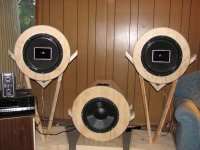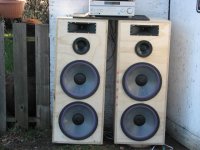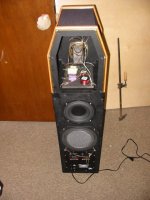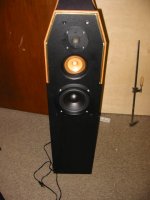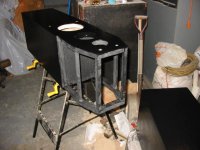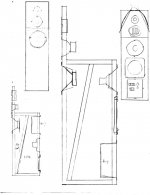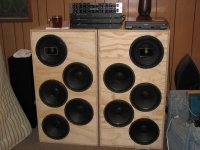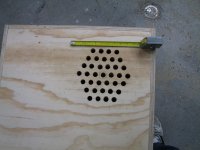Member
Joined 2009
Paid Member
I keep reading that Open Baffle is the dogs bollocks these days for sound quality. And a key reason is lack of box colourations. And especially the bass - afterall, many OBs use monopole tweeters. However, despite the wealth of objective data for speaker performance I've not found a link to information on box colourations. I'm wondering if it's become one of those concerns that people re-quote because they read it somewhere else. Is the benefit of OB really a lack of box-colourations or is it really all about dipole vs monopole and nothing to do with the box. How bad is box colouration when a box is built with care - good design and appropriate materials. Is the distortion down in the noise. Would anybody really build an OB just to escape from box colouration alone ? Or is it about the time delays of reflex and or TL enclosures, would the use of sealed boxes 'fix' this aversion. Or is it not about the box, but the standing waves that must occur in a BR/TL design even if the box were perfect (no vibrations at all) ?
Last edited:
Yes, I have built a few and that's the reason I do it.Is the benefit of OB really a lack of box-colourations
Everything to do with the box.and nothing to do with the box.
Less if built well but it's not just the box resonation that is a concern, it's the pressure waves inside.How bad is box colouration when a box is built with care
That's the only reason I would ever doing it. Everything is a compromise.Would anybody really build an OB just to escape from box colouration alone ?
Cheers.
Assuming you control the resonant modes in the box with enough Acousta-Stuf, acoustic tile etc. (and that's a big assumption), it's very difficult to build a box that doesn't have panel resonances at various frequencies.
A little bit of box coloration can be a good thing. It gives more "body" to the sound. These days I use multi-layer stacked panel approach to building the enclosure, to push resonances as high as possible. Variable wall thickness and non-parallel walls help to mitigate standing waves.
Attachments
Member
Joined 2009
Paid Member
A little bit of box coloration can be a good thing. It gives more "body" to the sound. These days I use multi-layer stacked panel approach to building the enclosure, to push resonances as high as possible. Variable wall thickness and non-parallel walls help to mitigate standing waves.
hmmm, interesting comment, but I'm not looking to add box colouration 'on purpose'. Your approach to making a good box looks superb. Did you try OB to compare ?
That's the only reason I would ever doing it. Cheers.
You are the 'man' when it comes to Big speakers so when I hear you like OB then it gets me curious. What's your approach to OB - do you have a thread ?
Last edited:
Boxes suffer from the internal volume (this also gives them their benefits). Many speaker boxes suffer from just being poorly constructed from a panel modes point of view, but an OB suffers from its own set of panel resonances.
dave
dave
I find that interesting as well.A little bit of box coloration can be a good thing.
It was planet10 that got me on the path. I have to admit I haven't found a way to make OB bass good for me but with mids, I will have a hard time doing anything else. Once Dave showed me the difference, the boxy sound I used to accept is now something I find unpleasant. Here are some front and back shots of 3 of them. The last one is a bunch of holes drilled in the rear but it offers the same relief. I have one set more underway.What's your approach to OB - do you have a thread ?
I guess only the first one is a true OB but they give me what I need in the way of no-boxy.
Attachments
You might trip over to Linkwitz to see what is involved with OB. Not easy. There is a whole sub culture (pun intended) dedicated to IB subs. I find it is easier to build a good box that to tame an OB. Others may have more skill than I. Sigfried Linkwitz for one.
In Ob you simply avoid the backwave to return to the membrane , after having traveled inside the box chaotically . Because the cone is so thin and it's acoustically transparent ,specially to the lowest tones , that they don't even 'see' the enclosure
Member
Joined 2009
Paid Member
I'm pretty sure I'm not as skilled as Linkwitz (or many other people who contribute on this forum) so I'll ask a related question:
Has anybody built a box speaker where they believe it has been designed and constructed to equal the 'no colouration' performance of an OB ?
I'm a little surprised - I didn't think Dave liked OB's much. He's a man with many talents.
I like some of those speakers you've built - the one with a special section behind for the mid-driver to be OB is unusual. The first one, well it does kinda look like a coffin 😀
The box with many holes looks cool, a giant kitchen appliance if I ever saw one ! - perhaps more like aperiodic than OB and that's something I know Dave is a big fan of. Do you find the many-holes works as well as a 'pure' OB ???
Has anybody built a box speaker where they believe it has been designed and constructed to equal the 'no colouration' performance of an OB ?
I find that interesting as well.
It was planet10 that got me on the path. I have to admit I haven't found a way to make OB bass good for me but with mids, I will have a hard time doing anything else. Once Dave showed me the difference, the boxy sound I used to accept is now something I find unpleasant. Here are some front and back shots of 3 of them. The last one is a bunch of holes drilled in the rear but it offers the same relief. I have one set more underway.
I guess only the first one is a true OB but they give me what I need in the way of no-boxy.
I'm a little surprised - I didn't think Dave liked OB's much. He's a man with many talents.
I like some of those speakers you've built - the one with a special section behind for the mid-driver to be OB is unusual. The first one, well it does kinda look like a coffin 😀
The box with many holes looks cool, a giant kitchen appliance if I ever saw one ! - perhaps more like aperiodic than OB and that's something I know Dave is a big fan of. Do you find the many-holes works as well as a 'pure' OB ???
Last edited:
I did make an "all-out" closed box speaker. 4-way active, superior drivers, stiff heavy well damped cabinet and so on..... I was shocked when I build my first OB, and discovered that even a very simple OB sounded a lot better in many aspects.
Has anybody built a box speaker where they believe it has been designed and constructed to equal the 'no colouration' performance of an OB ?
At least better than any OB we have had up on the mountain. One of the "boxiest" sounding speakers we've had up here was Silver Iris on OB.
The box with many holes looks cool, a giant kitchen appliance if I ever saw one ! - perhaps more like aperiodic than OB and that's something I know Dave is a big fan of. Do you find the many-holes works as well as a 'pure' OB ???
Except for Jimmy, Cal's boxes are not really OB. I'd have a go at loading up the back of the cavities in the larger ones with ultratouch insulation (after Gary Pimm).
dave
stiff heavy well damped cabinet and so on....
Details on the box? These could be a good candidtae for high energy storage -- which leads to a continuous low-level oozing of time-smeared sound from the box.
dave
Well... build from MDF with a lot of bracing, damped with more than 100 kg sand and asphalt. Separate boxes for all drivers.
The heavier the box, the more energy it can store I guess, but there was impossible to feel or measure any box vibration on those beasts....
The main problem was reflected sound from the cabinet volume. Initially I had filled the volumes entirely with damping, which was a bad idea. Damping material also reflects sound, a lot more than expected. After I removed a lot of damping material to gain some distance between the driver cones and the material, the sound got better, because the level of very early sound reflection went down.
The heavier the box, the more energy it can store I guess, but there was impossible to feel or measure any box vibration on those beasts....
The main problem was reflected sound from the cabinet volume. Initially I had filled the volumes entirely with damping, which was a bad idea. Damping material also reflects sound, a lot more than expected. After I removed a lot of damping material to gain some distance between the driver cones and the material, the sound got better, because the level of very early sound reflection went down.
Well... build from MDF with a lot of bracing, damped with more than 100 kg sand and asphalt.
Sand should be pretty good damping if it is loose, if mixed with the ashpalt and smeared on the MDF, likely just exacerbates MDF's energy storage issues.
The time smeared energy can readily go undetected even if you are looking for it, as it is 30-50 dB down from the main signals.
After the box is dealt with, sound coming back thru the cone becomes the biggest issue. Damping, shape, and low pressure are tools i use to minimize this (plus the drivers we use inevitably have a coating which reduces their tranmissive properties).
dave
Yes it is, but I'll tell you a little secret. I did it that way so I could rid it of the boxy midrange sound and at any time simply slap a piezo tweeter on the back in case I needed a dipole, or at least sound coming from the back.the one with a special section behind for the mid-driver to be OB is unusual.
Simply camera angle, the sides are parallel. 🙂The first one, well it does kinda look like a coffin 😀
Not sure, I just kept adding holes until they lost the boxy sound.Do you find the many-holes works as well as a 'pure' OB ???
By 'Jimmy' Dave means the coffin speakers. (I seem to have names for all my speakers.) and he is right. Attached is the framework for the cloth.Except for Jimmy, Cal's boxes are not really OB.
Haven't used them enough to know if that is needed yet but I will ask your advice when I get to doing that.I'd have a go at loading up the back of the cavities in the larger ones with ultratouch insulation (after Gary Pimm).
Attachments
I used loose sand between separate inner and outer boxes. This concept works very well. The asphalt (sheets) was used inside the boxes for additional damping. For acoustical damping inside the volumes I used a combination of rockwool (good at low frequencies) and wedge-shaped foam (low-reflecting surface and good at high frequencies). Midrange drivers was magnesium-cone Seas, which are pretty heavy and transmit less sound through the cone than thin paper cones. Woofers were Beyma's with coated paper cone.
I actually build a baffle-less OB with the same drivers, and it sounded way way better.
I actually build a baffle-less OB with the same drivers, and it sounded way way better.
Certainly heroic sounding cabinets. The layer of sand should negate issues with MDF.
I've never taken to rock-wool and don't use it. I gave up on acoustic foam a long time ago as not very effective (i do use a variation with some aperiodic venting)
dave
I've never taken to rock-wool and don't use it. I gave up on acoustic foam a long time ago as not very effective (i do use a variation with some aperiodic venting)
dave
Member
Joined 2009
Paid Member
StigErik,
I noticed somewhere else you don't use OB like most folk - you go to some lengths to treat the walls behind your OB's to greatly reduce reflections and as a result you found this a big improvement. So, I'm wondering, does this imply that for your ears OB just shifts the coloration from the box to the room and then it still has to be addressed ?
I noticed somewhere else you don't use OB like most folk - you go to some lengths to treat the walls behind your OB's to greatly reduce reflections and as a result you found this a big improvement. So, I'm wondering, does this imply that for your ears OB just shifts the coloration from the box to the room and then it still has to be addressed ?
- Home
- Loudspeakers
- Multi-Way
- Box colourations - really ?
